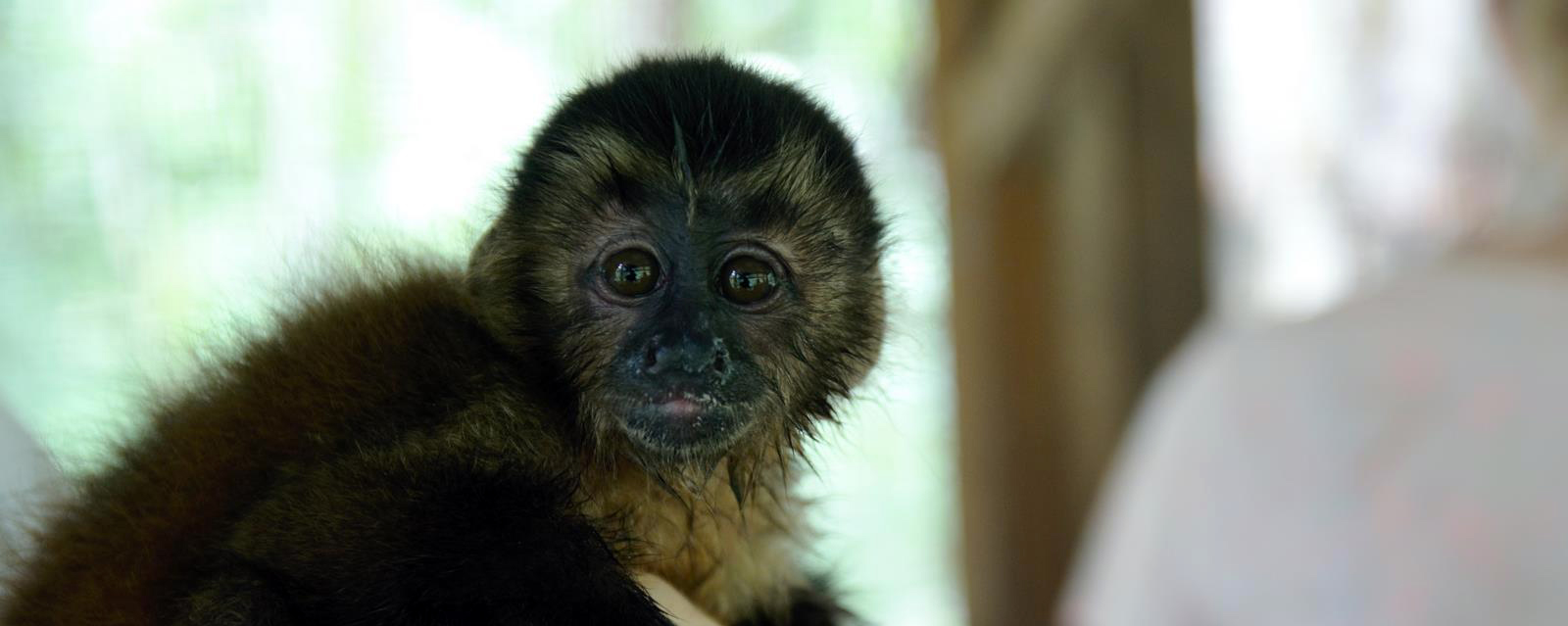General Info
We are sorry for the delayed update this month, a lot has been happening at Esperanza Verde lately! We have had several new additions to the rescue centre including two baby and 3 young capuchin monkeys, a baby woolly monkey, a baby howler monkey, some coati’s and a giant Ant-Eater. Unfortunately though, we also had a few deaths. We all do our best at Esperanza Verde to ensure the safety, health and eventual release of the animals we care for, but in some cases nature has to run its course and we can only learn from it.
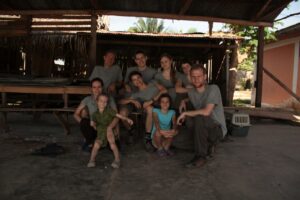
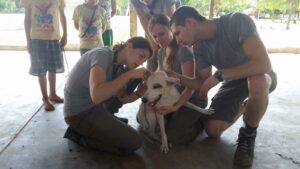
We have been fortunate to have Philipp Zerbe from Switzerland join us for 2 weeks, with 2 vet-students and 2 vets, also from Switzerland. They have been working hard every day, checking the animals for parasites, testing blood and feces samples, teaching Olivia and Douwe, and helping the volunteers. They also spayed the family’s cat Simba, as well as one male and one pregnant female cat, and a pig, belonging to one of the EV workers. They organized a deworming campaign in the village, so many dogs and cats were treated in the village. Aside from all of their amazing work, they also brought us medical equipment and transport cages and much more. Thank you vets! A special thanks to Philippfor making this all possible for us at Esperanza Verde as well for the learning experience for the veterinarians (and students). More news and photos of their visit soon can be found on the webpage of the Swiss Association Esperanza Verde.
We had a pretty full house with our guest, but it has been great to have all hands on deck, especially when there has been so much going on. It was a perfect timing with all these new animals arriving. Over the weekend we plan to bring everyone together for a big dinner and some well deserved drinks.
Monkeys

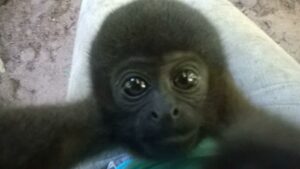
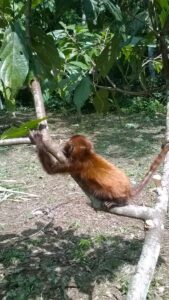
As mentioned, we have a few new monkey faces now. The first arrival included Cinty, a 6 month old female capuchin monkey; Chiquita, a 6 month old female woolly monkey and Kosho a 6 month old male howler monkey. They were brought to us by Noga who works with the Peruvian Government to rescue animals from illegal trade, so their ages are only rough estimates. Unfortunately one of the animals we lost this month was Kosho the howler after only 8 days. Howler monkeys have quite a complex digestive system and a high rate of depression so Kosho needed a lot of extra care for the time that he was with us, and a lot of encouragement to eat. He was showing good signs though, and his passing in the night was quite unexpected and sad for us all. Douwe performed an autopsy but the cause of his death is still uncertain.

On the positive side, both Cinty and Chiquita have been doing great! They have both been eating a range of fruits, vegetables and leaves, as well as drinking milk every day, and they love to play together. Cinty had some wounds around her waist when she arrived, from being tied up previously, but they have healed nicely now. Also Chiquita had a small lead pellet in her leg, which we have removed and has also healed really well. As with a lot of the monkeys that come here it was most likely from her mother being shot and killed.
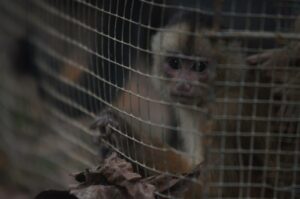
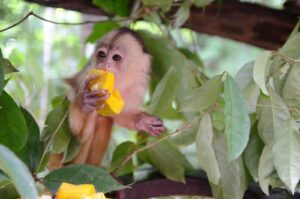
Then there was the next arrival: 3 more monkeys (originating from the zoo in Pucallpa), 2 white-fronted juvenile female capuchins (now named Chaira and Xira), and a juvenile female brown capuchin (named Nera).
The ministry of Fauna and Flora from Pucallpa brought them together with a baby male brown capuchin (named Khali), which was confiscated in the illegal market in Pucallpa.
Nera, Chiara and Xira, all had a medical check-up by the veterinarians, were treated for parasites and are now adjusting in a outside cage, till it is time to be introduced in the outside world at Esperanza Verde.

Khali is under care of Olivia and Douwe, at there house. He was full of parasites, has been treated accordingly and will then start spending time with Cinty and Chiquita (see above).
Yanay (female spider monkey) is pregnant! Gestation periods for Spider monkeys is generally around 7 months, and we estimate that she is possibly at about 5, so we will expect to see another baby around March-April. She is still quite independent, although sometimes she can cling on to your leg, and being one of the larger and heavier monkeys here it can be difficult to get her off. As always, we have a no touching policy and don’t encourage this behavior (no matter how cute!).
Nakoya (female woolly monkey) has a parasite at the moment, so the vets are currently working closely with Olivia and Douwe to establish the best treatment plan for her.
As for the others, they are all happy, healthy and as always very playful.
Other Mammals
The opossums (mouse opossums) were recently released from their cage. We continued to feed them their usual food, but leaving their cage door open for them to roam freely, and for a few days afterwards we were still seeing them each day. Unfortunately after about 5 days one of the volunteers found one had died in the cage. The autopsy showed a puncture through one side, with a broken rib, lung puncture and some abdominal bleeding, so he was likely attacked by something. The other 4 we haven’t seen lately, but we hope they have had more success.
Rincay (male Brazilian tapir) has had some trouble lately with tics, particularly around his eyes and behind his ears. He received some treatment the other day, which has heavily reduced the amount of tics on him, but we still need to be vigilant in checking him every day. He is still happy though, and the friendship between him and Willow (male woolly monkey) is just too cute.
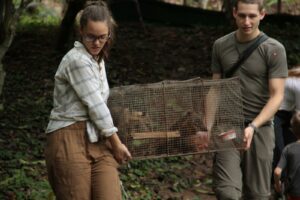
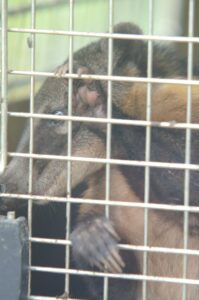
Together with the arrival of the capuchins came 7 Coatis, 4 adults (one male, three females) and 3 babies (two females, one male). They were given by the zoo in Pucallpa. They looked like they were relatively healthy and their behavior was fine, the mother started making a nest on one of the food tables so we had no reason to doubt that anything was abnormal. Unfortunately the next morning one of the veterinarians went to check on them and found that two of the babies had died. One of them was missing its brain, the other missing several other organs, eaten by the adult coatis, which is not abnormal behavior when a baby dies. From the autopsy, nothing could be established for the baby missing the brain, however the other had puncture wounds in its side and internal bleeding to suggest that it was injured and bled before it died, so it might have been attacked by one of the adults. The other young, a female, has been fine since, and her mother is taking good care of her.
We also had the arrival of a giant anteater which arrived the day after the capuchins and coatis. Someone caught him in the wild and he was confiscated and within the same week brought to us. He received a medical check in Pucallpa and it was decided he should be released as soon as possible. After seeing all was well with him upon arrival, we released him instantly on the path to the viewpoint.
Birds
With the arrival of so many new family members, the birds have had to do some moving around. Two of the parakeet cages have been emptied, separating those that can fly and those that can’t. The parakeets that have full feathers and can fly have been moved into the Igor cage to be released, where we leave a latch door open during the day. Unfortunately the student vets have found that this cage contains some parasites, so we have stopped releasing them for the moment to determine where the parasite has come from. All the other parakeets remain together as they have had their wings cut or pulled out prior to coming to Esperanza Verde, which can take up to 1 year to grow back.
Pauki (Oropendola) is still flying freely, checking in on us and stealing the food as the volunteers are trying to work. The last few days we haven’t seen him as much, but this morning he was spotted with another wild Oropendola so he is probably having too much fun to come home.
From our Aviary, one of the volunteers found one of our parrots Tamaya with her wing stuck in the mesh of the cage, most likely during a fight with one of the macaws. Thanks to our volunteer Jack for his prompt action in helping her to be freed; she recovered quickly with the treatment the veterinarians gave her, while being in a separate cage in the office.
Construction

The clinic is coming along quite nicely now! All the windows have been completed; the sinks have been put in and the surrounding tiling completed. The painting is well under way as well, and it is looking fantastic! Unfortunately because of the arrival of new animals and the extra attention that the baby monkeys require the volunteers haven’t been able to spend as much time helping, but Douwe and Geiler have been working very hard to keep up the speed. We aim to have the clinic finished and operational by April.
There has also been some restoration of steps, and some volunteers helped Douwe to build a large rabbit cage at the family house. We have had a bit of wet weather lately, so the cages have needed some restoration and installation of roof plates so that the animals still have shelter from the rain.
Volunteers
There are currently 8 volunteers and 2 vets and 2 vet students, one of which will be staying on as a volunteer for 2 weeks after her course has finished. The house is quite full, with some of the students sleeping in the two spare beds above the volunteer kitchen, but they will be leaving in only one week. Our head volunteer Dominik has taken a well deserved break, travelling for two weeks, so two other long term volunteers Shani and Morgane have stepped in his place. Carl has just left us, but during his stay he spent a lot of his time helping with the reforestation project to plant new trees, check existing ones and also data entry. Using the GIS system, Carl managed to enter and map the location of over 700 trees that have been planted in recent years, allowing us to better track their growth, as well as determine new locations for future projects.
Thank you to all of our volunteers for their help, and a big thank you to all of our supporters.

